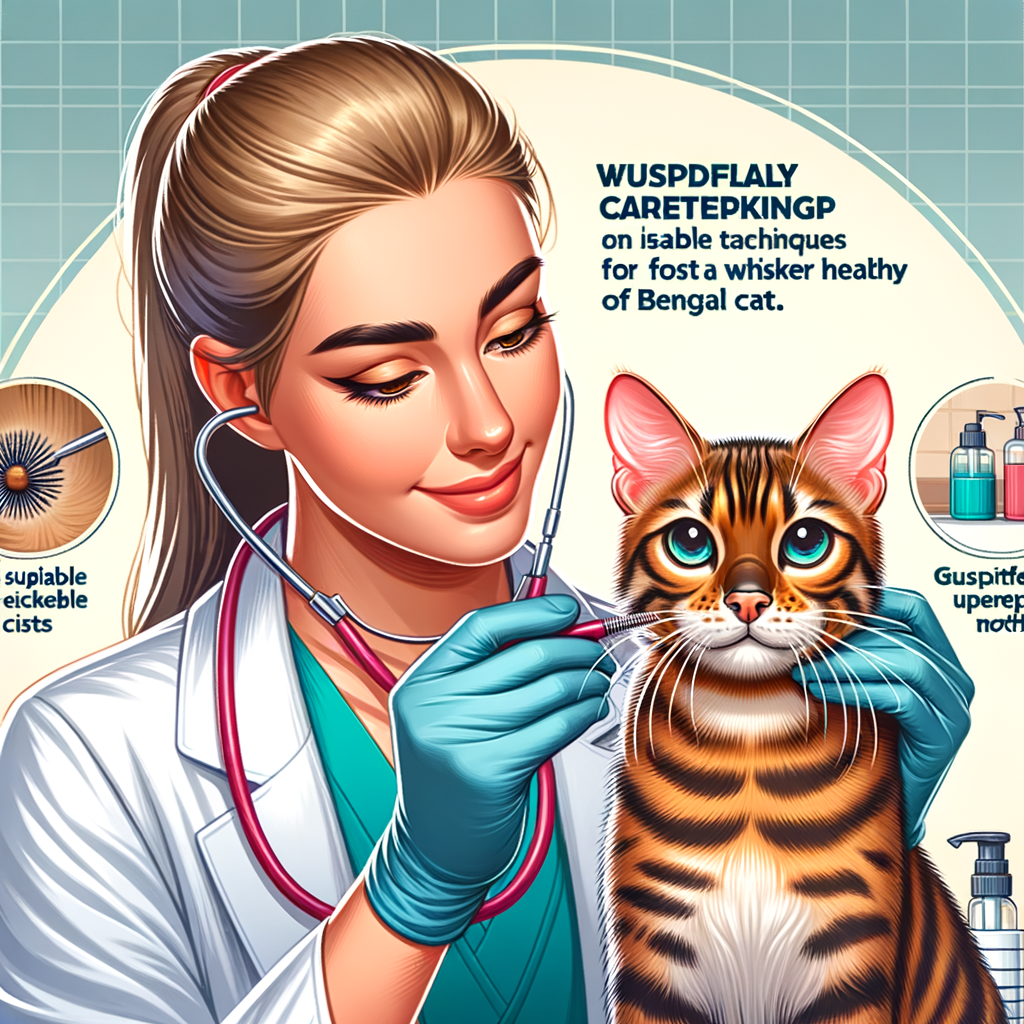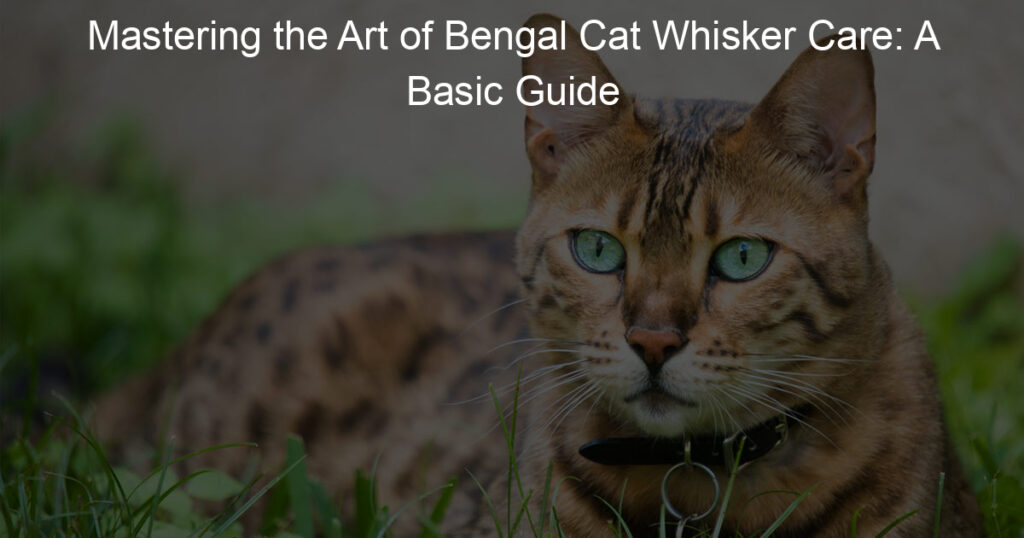
Introduction to Bengal Cat Care
When it comes to the world of felines, Bengal cats are a unique breed with their own set of needs and characteristics. This article will guide you through the basics of Bengal cat care, focusing on their distinctive whiskers.
Bengal cats are not your average house cats. Originating from the wild Asian leopard cat, they are known for their strikingly beautiful and wild-looking coats. But their uniqueness goes beyond their appearance. Bengal cats are highly active, playful, and intelligent. They require mental stimulation and physical activity more than many other cat breeds. Their distinctive whiskers are not just for show, they serve important functions too.
Given their unique characteristics, Bengal cats require specialized care. This includes a balanced diet, regular exercise, mental stimulation, and, of course, proper whisker care. Whiskers are crucial for a cat’s navigation and sensory perception. For Bengal cats, their whiskers are even more important due to their active and curious nature. Therefore, understanding and providing the right care for these whiskers is a vital part of Bengal cat care.
In the following sections, we will delve deeper into the fascinating world of Bengal cat whiskers, their maintenance, and care tips. So, whether you’re a proud Bengal cat owner or considering adopting one, this guide will equip you with the knowledge you need to ensure your Bengal cat is healthy and happy.
Understanding Bengal Cat Whiskers
Whiskers are a fascinating feature of Bengal cats. They are not just for show but play a significant role in the cat’s daily life. Let’s delve into understanding the role of whiskers in Bengal cats.
Role of Whiskers in Bengal Cats
Whiskers serve two main purposes in Bengal cats. They act as sensory tools and aid in communication. Let’s explore these roles in detail.
-
- Whiskers as sensory tools
Whiskers, also known as vibrissae, are highly sensitive tactile hairs that guide Bengal cats in their environment. These whiskers are rooted much deeper in the cat’s body than the top fur coat. They are connected to the muscular and nervous system, sending information about the surroundings directly to the cat’s sensory nerves. This gives Bengal cats an acute sense of their surroundings, even in the dark. Whiskers can detect changes in air currents and vibrations, helping the cat to navigate and hunt.
-
- Communication through whiskers
Whiskers also play a crucial role in communication. The position of a Bengal cat’s whiskers can indicate its mood. For instance, whiskers that are pulled back against the face often indicate that the cat is scared or angry. On the other hand, relaxed whiskers that stick out sideways suggest that the cat is calm and content. By observing the position of your Bengal cat’s whiskers, you can better understand its feelings and reactions.
In conclusion, whiskers are an essential part of a Bengal cat’s sensory and communication systems. They help the cat to navigate its environment and express its emotions. Understanding the role of whiskers in Bengal cats can help you to better care for your pet and interpret its behavior.
Unique Characteristics of Bengal Cat Whiskers
When it comes to Bengal cats, their whiskers are not just ordinary facial features. They possess unique characteristics that set them apart from other breeds. Let’s delve into the specifics of these unique attributes.
-
- Length and Flexibility
Bengal cat whiskers are notably long and flexible. This is not a mere coincidence but a result of their wild ancestry. The length and flexibility of their whiskers allow them to navigate their environment effectively, just like their wild counterparts. The average length of a Bengal cat’s whiskers can range from 3 to 5 inches, which is significantly longer than many other domestic cat breeds. The flexibility of their whiskers also plays a crucial role in their agility and hunting prowess.
-
- Color and Thickness
The color and thickness of Bengal cat whiskers are also distinctive. Most Bengal cats have white or cream-colored whiskers, which contrast beautifully with their spotted or marbled coat. The thickness of their whiskers is also noteworthy. Bengal cats have thicker whiskers compared to other breeds, which enhances their sense of touch. This characteristic is particularly beneficial for Bengal cats as it aids them in hunting and exploring their surroundings.
In conclusion, the whiskers of Bengal cats are not just aesthetically pleasing but also serve practical purposes. Their length, flexibility, color, and thickness are all unique characteristics that contribute to their exceptional sensory abilities and overall charm.
Bengal Cat Whisker Maintenance
When it comes to Bengal cats, their whiskers are not just an adorable feature but also an essential part of their sensory system. Proper maintenance of these whiskers is crucial for the well-being of your Bengal cat. In this section, we will discuss the basic care for Bengal cat whiskers.
Basic Care for Bengal Cat Whiskers
There are two primary aspects of basic care for Bengal cat whiskers: regular grooming and avoiding whisker stress. Let’s delve into each of these aspects.
-
- Regular Grooming:
Regular grooming is an integral part of whisker care. It helps keep the whiskers clean and free from dust or food particles. While grooming, make sure to be gentle and avoid pulling or trimming the whiskers. Unlike fur, whiskers are sensitive and trimming them can cause discomfort and disorientation in your cat.
-
- Avoiding Whisker Stress:
Whisker stress, also known as whisker fatigue, is a condition that can occur when a cat’s whiskers come into constant contact with the sides of their food or water dish. This can be avoided by using wide, shallow dishes for your Bengal cat’s food and water. It’s also important to provide a safe and spacious environment for your cat to explore, as cramped spaces can lead to whisker stress.
By following these simple steps, you can ensure that your Bengal cat’s whiskers remain healthy and functional. Remember, a happy cat is a cat with well-maintained whiskers!
Bengal Cat Whisker Health
Whisker health is a crucial aspect of overall wellness for your Bengal cat. Let’s delve into the signs of healthy whiskers and common whisker health issues, along with their solutions.
- Signs of Healthy Whiskers in Bengal Cats
Healthy whiskers in Bengal cats are typically straight and stiff, with a smooth surface. They are evenly spaced and have a uniform length. The color of the whiskers usually matches the cat’s fur color. Healthy whiskers are flexible and can move freely, allowing the cat to navigate its surroundings effectively. If your Bengal cat’s whiskers meet these criteria, you can rest assured they are in good health.
- Common Whisker Health Issues and Their Solutions
Despite their robust nature, Bengal cat whiskers can sometimes face health issues. Here are a few common ones:
| Whisker Health Issue | Solution |
|---|---|
| Whisker Fatigue | Use shallow food and water dishes to prevent overstimulation of the whiskers. |
| Broken Whiskers | Keep your cat’s environment safe and free from hazards that could break the whiskers. |
| Whisker Loss | Consult a vet immediately, as this could be a sign of health issues. |
Remember, whisker health is an important part of your Bengal cat’s overall wellbeing. Regular check-ups and maintaining a safe environment can go a long way in ensuring your cat’s whiskers stay healthy.
Whisker Care Tips for Bengal Cats
When it comes to Bengal cats, their whiskers are an essential part of their anatomy. They use them for various purposes, such as sensing their surroundings and expressing their emotions. Therefore, it’s crucial to know how to properly care for them. Here are some do’s and don’ts of Bengal cat whisker care:
Do’s and Don’ts of Bengal Cat Whisker Care
- Never trim or cut the whiskers: It might be tempting to trim your Bengal cat’s whiskers, especially if they seem too long. However, this is a big no-no. Whiskers are sensory tools for cats. They help them navigate their environment, measure openings, and even detect changes in air currents. Cutting them can cause disorientation and stress for your cat.
- Provide whisker-friendly food and water dishes: Did you know that some cats dislike eating or drinking from certain dishes because they touch their whiskers? This is known as ‘whisker stress’. To avoid this, use wide, shallow dishes for food and water. This way, your Bengal cat can comfortably eat and drink without their whiskers touching the sides of the dish.
Remember, whisker care is an essential part of your Bengal cat’s overall health and well-being. By following these tips, you can ensure that your furry friend is comfortable and happy.
Case Study: Successful Whisker Care Practices
Let’s take a closer look at two case studies that highlight the importance of proper whisker care for Bengal cats.
-
- Case Study 1: Whisker-Friendly Feeding
Meet Bella, a beautiful Bengal cat who used to struggle with eating. Her owner noticed that Bella would often leave food in her dish, even when she seemed hungry. After some research, they discovered that the problem was the dish itself. It was too narrow, causing Bella’s sensitive whiskers to brush against the sides, which was uncomfortable for her.
They switched to a shallow, wide dish, and Bella’s eating habits improved significantly. This case study shows how a simple change in feeding practices can make a big difference in a Bengal cat’s comfort and health.
-
- Case Study 2: The Impact of Stress on Whiskers
Next, let’s consider Max, a Bengal cat who started losing his whiskers. His owner was worried and took Max to the vet. The vet asked about any recent changes in Max’s environment. It turned out that there had been a lot of loud construction noise near Max’s home recently.
The vet explained that stress can cause whisker loss in cats. Max’s owner took steps to create a calmer environment for Max, and his whiskers eventually grew back. This case study underscores the importance of a stress-free environment for maintaining healthy whiskers.
These case studies illustrate that whisker care goes beyond just physical maintenance. It also involves creating an environment that is comfortable and stress-free for your Bengal cat.
Conclusion: Bengal Cat Whisker Care Guide
As we conclude our comprehensive guide on Bengal cat whisker care, it’s important to recap the key takeaways and share some final thoughts on maintaining healthy whiskers in these beautiful felines.
-
- Recap of Key Takeaways
Our journey began with understanding the unique characteristics of Bengal cat whiskers. We learned that these are not just ornamental but serve a crucial role in the cat’s navigation and sensory perception. The importance of whisker health was emphasized, highlighting the need for regular checks and proper grooming.
We then delved into the specifics of whisker maintenance, where we discussed the importance of a balanced diet, regular grooming, and avoiding whisker stress. We also shared some practical tips for whisker care, including using wide food and water dishes, avoiding plastic bowls, and being mindful of the cat’s environment.
-
- Final Thoughts on Maintaining Healthy Whiskers in Bengal Cats
As we wrap up, it’s clear that taking care of your Bengal cat’s whiskers is an integral part of their overall health and well-being. By following the tips and guidelines shared in this guide, you can ensure that your Bengal cat’s whiskers remain healthy and functional.
Remember, a happy cat is a healthy cat. And a healthy cat has well-cared-for whiskers. So, let’s make whisker care a priority in our pet care routine. After all, our feline friends deserve the best!
Thank you for joining us on this journey of understanding and caring for Bengal cat whiskers. We hope this guide has been informative and helpful. Here’s to happy, healthy whiskers!














